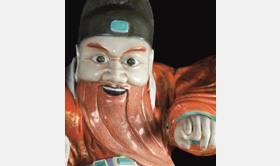Massive Figure of a Demonslayer
Qianlong, c. 1740
Height: 25 ¾ inches (65.5cm)
Source: Cohen & Cohen
Download Full SpecificationBack to List...
A massive figure of Zhong Kui in famille rose porcelain, with a sword in his right hand and his left held up in a threatening pose, in robes of iron red and green, sculpted in swirling folds, with two belts of simulated jade and precious stones, the face painted in f lesh tones with dramatic eyebrows and beard.
This extraordinary figure is unrecorded. The quality of execution, both in the enamelling and the sculptural dynamism, especially in the folds of the robes, suggests that this was made for an imperial commission. There is no precedent within Chinese porcelain, export or imperial, for a figure of this type. The size alone would have made it extremely difficult to fire. The cost of manufacture would have been prohibitive for the export or domestic markets, other than for the emperor. The enamelling is detailed and similar to examples of imperial porcelain. The sword a replacement and might originally have been of another material, possibly jade.
This has emerged from an old private collection in Europe. Given the quality, it is possible that this was looted from the Summer Palace (Yuanming yuan) outside Beijing. Other items from there have resurfaced in European houses throughout the twentieth century.
As a young man, Zhong Kui travelled with his friend Du Ping to take the official examinations, which were essential for success. He took top honours but was disallowed by the emperor because of his disfigured appearance. In a fury, the student threw himself at the imperial gates until his head was broken; his body was taken and buried by Du Ping, who later married his younger sister. Zhong Kui's spirit descended into hell, where he became King of the Ghosts and set about vanquishing demons. In the Tang dynasty, the sick Emperor Xuanzong was terrorised in his dreams by a demon until a fierce spirit with a sword attacked the demon and ate him. He introduced himself to the emperor as Zhong Kui, and the emperor commanded the artist Wu Daozi to paint his image. In the Song dynasty, Zhong Kui was absorbed into the Daoist pantheon.
Images of Zhong Kui are popular on gates and entrances to ward off evil spirits, and are especially important for business premises selling high-value goods. He is shown with his magic sword, a fierce expression, and big beard, usually in an energetic pose.
The Yuanming yuan, or Summer Palace, was begun by the Kangxi emperor in 1707 as a present for his son, the future Yongzheng emperor, who extended them into a whole complex of palaces and gardens with extensive water works, a pleasant place from which to conduct the Qing administration. The Qianlong emperor further developed the complex until is covered an area of almost nine hundred acres.
Although famous for the European-style palace designed by the Jesuit Guiseppe Castiglione with Michel Benoist, in fact most of the buildings were Chinese in style, with some Mongolian and Tibetan architecture. They were filled with porcelain, bronzes, and other works of art arranged in themes and made by the very best artists and craftsmen in the empire.
The European-style buildings were in stone, and so parts of them sur vived the catastrophic destruction brought about by the British and French troops in 1860–an act of cultural vandalism that still resonates today. This was ordered by Lord Elgin as punishment for the execution of twenty Western prisoners. Charles Gordon (of Khartoum) was present as a young captain and wrote af ter wards: ‘You can scarcely imagine the beauty and magnificence of the places we burned. It made one's heart sore.’
The Summer Palace took three days to burn. It was noted that the looters preferred the porcelain items, leaving behind the bronzes, many from the Shang and Han periods, which were rescued after wards. Whatever had sur vived was finally destroyed in 1900 by Western forces during the Boxer Rebellion.
Provenance:
- From a private European Collection, originating in France.
World Record price for a single export figure
Sold GBP 530,000 to a private US collector



